
A sawshark or saw shark is a member of a shark order bearing a unique long, saw-like rostrum edged with sharp teeth, which they use to slash and disable their prey. There are eight species within the Pristiophoriformes, including the longnose or common sawshark, shortnose sawshark, Japanese sawshark, Bahamas sawshark, sixgill sawshark, African dwarf sawshark, Lana's sawshark and the tropical sawshark.

The school shark is a houndshark of the family Triakidae, and the only member of the genus Galeorhinus. Common names also include tope, tope shark, snapper shark, and soupfin shark. It is found worldwide in temperate seas at depths down to about 800 m (2,600 ft). It can grow to nearly 2 m long. It feeds both in midwater and near the seabed, and its reproduction is ovoviviparous. This shark is caught in fisheries for its flesh, its fins, and its liver, which has a very high vitamin A content. The IUCN has classified this species as critically endangered in its Red List of Threatened Species.
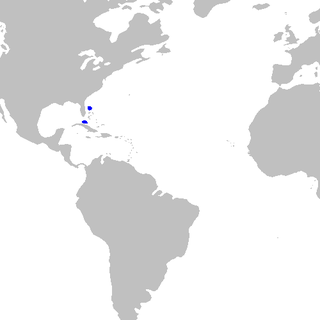
The Bahamas sawshark, Pristiophorus schroederi, is a sawshark of the family Pristiophoridae, found in the western Central Atlantic Ocean from the Bahamas and Cuba at depths of between 400 and 1,000 m. These sharks are at least 80 cm long.

The sixgill stingray is a species of stingray and the only extant member of the family Hexatrygonidae. Although several species of sixgill stingrays have been described historically, they may represent variations in a single, widespread species. This flabby, heavy-bodied fish, described only in 1980, is unique among rays in having six pairs of gill slits rather than five. Growing up to 1.7 m (5.6 ft) long, it has a rounded pectoral fin disc and a long, triangular, and flexible snout filled with a gelatinous substance. It is brownish above and white below, and lacks dermal denticles.
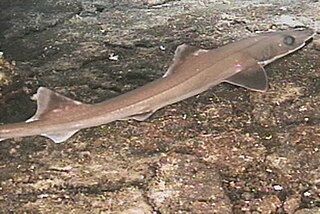
The slender smooth-hound or gollumshark is a species of ground shark in the family Pseudotriakidae. It is endemic to the waters around New Zealand, where it is usually found close to the bottom over the continental slope at depths of 300–600 m (980–1,970 ft). An extremely slim, plain brownish shark reaching 1.1 m (3.6 ft) in length, the slender smooth-hound can be identified by its broad, flattened head with a long, distinctively bell-shaped snout. Its mouth is angular with short furrows at the corners, and contains a very high number of tooth rows in both jaws. Its two dorsal fins are roughly equal in size.

The whitecheek shark or widemouth blackspot shark is a requiem shark of the family Carcharhinidae, found in the Indo-West Pacific Ocean between latitudes 34°N and 25°S. It can reach a length of 1 m. It feeds mainly on fish, cephalopods, and crustaceans. It is a viviparous species, with the female giving birth to up to four live young.

The shortnose sawshark, or southern sawshark, is a sawshark of the family Pristiophoridae. The body of this shark is slightly compressed, and its rostrum is narrow. The two dorsal fins are almost identical in size. In color, the dorsal side of this sawshark tends to be uniformly slate gray, with few or no markings. The ventral side is pale white or cream. Females reach around 124 cm (49 in) long, and males reach around 110 cm (43 in) long. These sharks can live up to 9 years.

The sixgill sawshark, Pliotrema warreni is a sawshark of the family Pristiophoridae. Presence of 6 pairs of gill slits highlights this genus among sharks; outside Hexanchiformes order, Pliotrema is the only shark with more than 5 gill slits. Unlike other sawsharks, the barbs on this shark's rostrum continue onto the sides of the head. Its barbels are also closer to its mouth than in other species. At maximum, females can reach over 136 cm long, and males can reach over 112 cm long.

The Japanese bullhead shark is a species of bullhead shark in the family Heterodontidae found in the northwestern Pacific Ocean off the coasts of Japan, Korea, and China. This benthic shark occurs at depths of 6–37 m (20–121 ft) over rocky bottoms or kelp beds. Measuring up to 1.2 m (3.9 ft) long, it can be identified by its short, blunt head, two high dorsal fins with anterior spines, and pattern of irregularly shaped, vertical brown bands and stripes. The Japanese bullhead shark is a docile, slow-swimming species that feeds mainly on shelled invertebrates and small bony fishes. Reproduction is oviparous, with females laying spiral-flanged eggs in communal "nests". This species is of little interest to fisheries.

The pygmy ribbontail catshark is a species of finback catshark, family Proscylliidae, distributed patchily in the western Indo-Pacific from Tanzania to the Philippines. It occurs around the edges of continental and insular shelves at a depth of 71–766 m (233–2,513 ft), typically on or near mud bottoms. One of the smallest living shark species, the pygmy ribbontail catshark grows to a maximum known length of 24 cm (9.4 in). It has a slender body with a low, ribbon-like tail fin, and is dark brown in color with blackish dorsal fin markings and tail bands. This shark feeds mainly on bony fishes, followed by crustaceans and then squid. It is aplacental viviparous with females bearing litters of 1–2 relatively large pups. It is of minimal significance to fisheries, being caught as bycatch in some areas.

The blotchy swellshark, or Japanese swellshark, is a common species of catshark, belonging to the family Scyliorhinidae. The Blotchy swellshark is found at depths of 90–200 m (300–660 ft) in the northwestern Pacific Ocean, from Japan to Taiwan. It is benthic in nature and favors rocky reefs. Reaching 1.4 m (4.6 ft) in length, this thick-bodied shark has a broad head, large mouth, and two unequally-sized dorsal fins positioned far back past the pelvic fins. It can be identified by its dorsal coloration, consisting of seven brown "saddles" and extensive darker mottling on a light tan background. This species has often been confounded with the draughtsboard shark and the Sarawak pygmy swellshark in scientific literature.
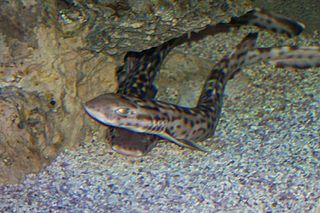
The coral catshark is a species of catshark in the family Scyliorhinidae. It is common on shallow coral reefs across the Indo-West Pacific, from Pakistan to New Guinea. Reaching up to 70 cm (28 in) in length, the coral catshark has an extremely slender body, a short head and tail, and two dorsal fins that are angled backwards. It can be identified by the numerous black and white spots on its back, sides, and fins, which often merge to form horizontal bars. Furthermore, adult males have distinctively long and thin claspers.

The Japanese roughshark is a rare species of shark in the family Oxynotidae, known only from a handful of specimens recovered from Suruga Bay and the Enshunada Sea off Japan. It is a benthic species that occurs at a depth of 150–350 m (490–1,150 ft). This shark is caught as bycatch by bottom trawlers throughout its entire limited range, and may be threatened given the declines in other bottom deep sea species in Suruga Bay.

The Caribbean roughshark is a rough shark of the family Oxynotidae, found on the upper continental slopes of the Caribbean Sea, at depths between 400 and 450 m. It reaches a length around 50 cm (20 in).
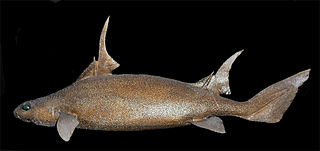
The sailfin roughshark is a species of dogfish shark in the family Oxynotidae, found in the eastern North Atlantic from Scotland to Senegal between latitudes 61°N and 11°N, at depths of between 265 and 720 m. Its length is up to 1.2 m (3.9 ft).

The banded houndshark is a species of houndshark in the family Triakidae, common in the northwestern Pacific Ocean from the southern Russian Far East to Taiwan. Found on or near the bottom, it favors shallow coastal habitats with sandy or vegetated bottoms, and also enters brackish water. This shark reaches 1.5 m (4.9 ft) in length. It has a short, rounded snout and mostly narrow fins; the pectoral fins are broad and triangular, and the trailing margin of the first dorsal fin is almost vertical. It is gray above and lighter below; younger sharks have darker saddles and dots, which fade with age.

The spotless smooth-hound is a species of houndshark, in the family Triakidae, found on the continental shelves of the northwest Pacific, between latitudes 40° N and 11° N, from the surface to a depth of 300 m. It can grow to a length of up to 1 m.

The Australian angelshark is a species of angelshark, family Squatinidae, found in the subtropical waters of southern Australia from Western Australia to New South Wales between latitudes 18°S and 41°S, at depths down to 255 m (840 ft). Its length is up to 1.52 m (5 ft). Reproduction is ovoviviparous, with up to 20 pups in a litter.
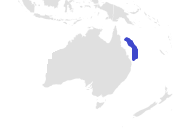
The tropical sawshark, Pristiophorus delicatus, is a recently described species of sawshark, family Pristiophoridae, formerly known in literature as Pristiophorus sp. B. It is endemic to northeastern Australia, found on the upper continental slope off Queensland from south of the Samaurez Reef, at a depth of 246–405 meters (807–1,329 ft). Its specific epithet delicatus is Latin for "delicate", referring to the fine teeth on its saw-like rostrum.
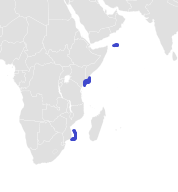
Pristiophorus nancyae, the African dwarf sawshark or dwarf sawshark, is a sawshark of the family Pristiophoridae. The species was discovered in 2011 when a specimen was caught off the coast of Mozambique at a depth of 1,600 ft (490 m).






















